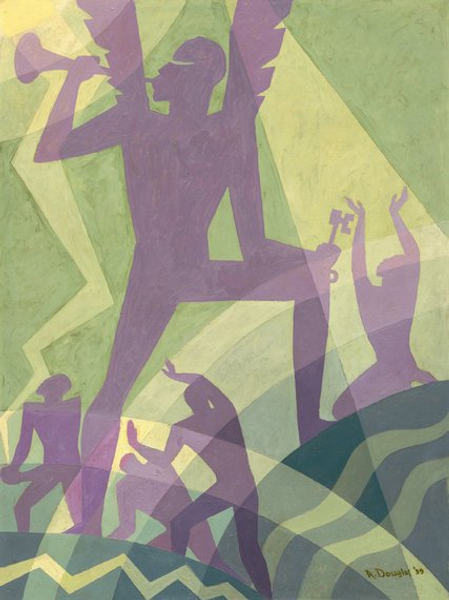
painting, acrylic-paint, mural
#
narrative-art
#
painting
#
caricature
#
pop art
#
harlem-renaissance
#
acrylic-paint
#
figuration
#
geometric
#
abstraction
#
cityscape
#
mural
#
modernism
Dimensions: 22 x 22 cm
Copyright: Aaron Douglas,Fair Use
Song of the Towers (1934) by the painter Aaron Douglas forms one of four murals he created to record aspects of the African American experience during the early 1930s. Commissioned for the New York Public Library, the four murals explore themes of racism, class oppression, progress, and optimism. Completed in Douglas’ distinctive style of geometric outlines, Song of the Towers depicts a silhouetted figure carrying a saxophone above his head. Circles of light, symbolising sound waves or ripples of hope, emanate from the saxophone. In the foreground, smoking chimneys and an industrial turning wheel act as symbols of urbanisation and manufacturing. The figure stands on top of the wheel, with his hands raised in an expression of victory. Perhaps he has escaped the hardships of the past, and is looking out towards an optimistic future. Between two blocks of skyscrapers is the Statue of Liberty, a clear emblem of prosperity and The American Dream. Aaron Douglas was a major figure in the Harlem Renaissance, a rich African American cultural movement beginning in New York after the First World War. The Harlem Renaissance was a period of vibrant creativity in the visual arts, as well as in literature, music, and theatre. Douglas incorporated a diverse range of stylistic influences, from traditional African motifs to the angular shapes of Art Deco and Cubism. In Song of the Towers, Douglas highlights the power of jazz music in providing a pathway out of oppression. The mural can be seen as an optimistic portrayal of Black excellence and hope for the future, both of which are typical subjects of the Harlem Renaissance. What might the mural tell us about African American culture in the 1930s? Editor: Lucy Jude Grantham
Comments
No comments
Be the first to comment and join the conversation on the ultimate creative platform.













